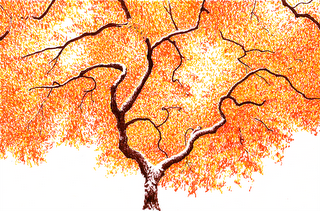Chapter XLVIII: Que Seurat, Seurat
Image of the Day: Scan of pointillist maple tree, using maroon, yellow, and red gel pens. Click to Enlarge
What color is Georges-Pierre Seurat's hair? You may have no idea, but you have, at some point, seen his most famous painting, titled "Sunday Afternoon on the Isle of La Grande Jatte." The 1886 tableau is regarded as one of the most remarkable artworks of the 19th century, and is widely alluded to in popular culture. Just last night, I saw it featured prominently in a TV ad for Acuvue brand contact lens.
It famously uses pointillism, or the application of varying densities of discrete dots to create an image. In all, "Sunday Afternoon" is composed of over three million individually applied dots of paint and took over two years for Seurat to complete the 7' x 10' canvas. He didn't choose this grueling method on a whim, of course, but was trying (unsuccessfully) to use new developments in optical theory**.
A couple weeks ago, I got some taste of what a pain in the ass pointillism can be by producing what you see above.
I have no idea how many million dots I used, but it took six hours. My hand and brain went numb at the same time and I transformed into a pointillism zombie. Seriously, I only thought about three things in that entire period--'maroon,' 'red,' and 'yellow.' In any case, I'm reasonably happy with how it came out and when I have time during the summer, I plan to redo it on heavier 18" x 24" paper (this was 8.5" x 11") with four colors instead of three. Zebra SARASA, the brand of pen I used, now also comes in orange.
**Specifically, it was discovered that contiguous dots of contrasting color merge to form a single hue in the viewer's eye (more vibrant than if a single color had been used). However, Seurat's dots were actually too big to achieve the dithered effect at normal viewing distances, hence the appearance of graininess that is trademark Seurat.
That's all.


No comments:
Post a Comment